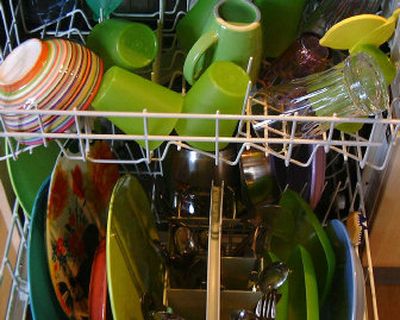Dishwashers should clean, but not be heard

Hear that? It’s the sound of dishwasher manufacturers lowering the machines’ noise levels.
“As home plans become a lot more open, you want to be able to talk over the phone and not shout over the noise of a dishwasher,” said Brent DeWeerd, who oversees dishwasher engineering at Whirlpool Corp.
He says Whirlpool has quietly addressed dishwasher noise issues because hushed operation is a key thing consumers look for in a machine.
Indeed, consumer Jennifer Burns expects her dishwasher to clean pots and pans, not drown out normal conversation or the TV news.
“You just hear all the water and the motion, and it’s just disruptive,” said Burns, a homeowner in Charlotte, N.C. “It makes me turn up the TV, which bugs me. I want to be able to hold a normal conversation in my living room without it making too much noise.”
The din from loud dishwashers is a pet peeve of homeowners who expect a machine to quietly go about its business.
Appliance-makers are heeding the demand from consumers about noise levels, DeWeerd says, noting that some manufacturers now promote their noise-abatement remedies with names like Quiet Partner IV Sound Package, QuietGuard Supreme or Premium LoDecibel Quiet Operation.
But building a quieter dishwasher is more about decibels than marketing. In the past 18 months, appliance-makers have come together to create an industry standard for monitoring dishwasher sound levels after years of using their own criteria for measuring sound.
Older dishwashers – those 10 years old or more – have earsplitting decibels of 65 or higher. (The lower the decibel level, the quieter the machine.) Less expensive dishwashers crank out decibel levels above 60 decibels, while top-end models are comparatively whisper-quiet at 45 decibels.
What’s behind all the hubbub? The two main sources of dishwasher noise are the pump and water sloshing against the tub walls, says DeWeerd.
To combat noise, manufacturers surround the noise makers with a thick layer of mastic, a stiff insulator that muffles lower noise frequencies. The mastic is wrapped around the tub and pump compartments, then encased in a fluffy blanket of insulation to help dampen higher frequencies.
What’s more, dishwashers made today operate more efficiently, cleaning dishes in a shorter period of time and contributing to lower sound levels.
“We flow a lot less water than we did historically,” says DeWeerd. “Before, sprays of water generated sound like beating on a drum.”
So how much will a little peace and quiet set you back?
You can expect to pay extra for superior noise dampening. Sears’ top dishwasher, a Kenmore with a decibel rating of 48, retails for $870, while a model with 59 decibels sells for $550. Whirlpool models range from $750 for 51 decibels to $450 for 61 decibels.
But how do you know the thing’s working if it’s not making any noise? Not to worry. Some have a red laser beam to assure you that the dishwasher is silently humming and scrubbing away.
But for homeowners like Burns, a near-silent machine sounds like a blissful investment. “I’m ready to have some piece and quiet,” she said. “My old dishwasher cleans great, but it’s as noisy as a freight train.”